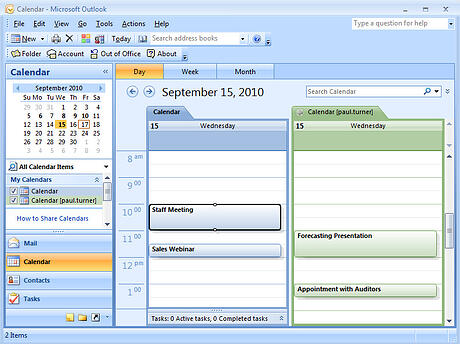Priority Management
A calendar system typically uses a month-at-a-glance page(s), week or daily view. The month page is a bird’s-eye view of tasks and deadlines to come; this view becomes useful for scheduling a month in advance. The daily sheet should contain three areas: time slots for scheduled appointments; tasks for prioritizing what needs to get done that day; and an area for comments or jotting down a record of additional daily events. You can accomplish the same thing using Microsoft OutlookTM.

DAILY ACTIVITIES:
- Each morning, you should think, plan, and track the day by accomplishing these tasks:A.Review your monthly calendar for appointments and tasks previously set for the day, as well as reports or items that are due to you, and record them in the daily system.OUTLOOK: These appointments, including travel time, would be entered on your Outlook calendar and tasks would be entered in your Outlook tasks. A reminder will pop up 15 minutes prior to the time you set up and will stay on your computer screen until you click “Dismiss” or “Snooze” to be reminded again later. Reports and items due you would also be listed in your task list with the responsible person’s name and a date. You can also put Project folders with project specific tasks in Outlook with the responsible person’s name and date. You can print your calendar and the task lists from Outlook. To maximize the effectiveness of Outlook, you should share calendars and tasks with your key employees (and they should be using Outlook for appointments and tasks). This will allow you to view progress on assigned tasks and changes to calendars.B. Review the previous days’ tasks and reschedule any incomplete tasks.OUTLOOK: You previous days’ tasks and incomplete tasks would be in your task list. The previous days’ tasks should be checked off and incomplete tasks will appear in red type. You can change the due date of the task to reschedule it and the type will change to black.C. Prioritize tasks.
OUTLOOK: You can categorize your tasks (this is a custom process) by color using the “Categorize” button in that tasks’ window. In addition, you set the priority (low, normal and high) by using the “Prioritize” button. Priority notations appear in the task list, as the first item in that line, as a red exclamation point for high priority, a blue arrow pointing down for a low priority and no notation for normal priority.
D. Decide what you need to accomplish for the day and what you can delegate to others.
OUTLOOK: Tasks that you want to delegate to others can be accomplished using the “Assign Task” button. This button requires you to type the name of the person you are assigning the task to. Outlook will automatically keep the updated task on your task list and will send a status report when the project is complete.
E. Notify people of tasks you are delegating to them for the day.
OUTLOOK: When tasks are assigned (See above) the assignee receives an email notice of the task and gives the option to accept, decline, or accept with comment. Once accepted, that task goes on the employee’s task list while staying on the assignor’s task list.
F. Review with each employee tasks that are due that day.
OUTLOOK: When tasks are assigned to an employee a due date is also assigned. These assigned tasks will appear on the employee’s task list and if a priority is assigned it will also appear. Because all tasks are entered in Outlook you can easily see what is due when and can also send an email reminder.
G. Reschedule tasks when necessary and record barriers/problems on an Action Plan worksheet.
OUTLOOK: If the employee is unable to complete the task and changes the due date, that change is transferred to the assignor. Any problems can be emailed.
- Throughout the day, record tasks and the time it took to complete them on your Daily Time Sheet.OUTLOOK: Record tasks and time to complete them in your daily calendar.
AT THE END OF EACH WEEK: Review, Analyze, and Adjust for variables.
- Review Daily Time Logs and list recurring tasks and delegate what you can to others.OUTLOOK: You can review shared calendars and task lists. When recurring tasks are entered on a task list they can be set up to automatically appear on the task list by clicking on the “Recurrence” button. You can select daily, weekly, monthly, yearly or a number of appearances on the task list
- Record recurring tasks on your monthly calendar by blocking out that time.OUTLOOK: Recurring appointments can be set up to automatically appear on your calendar by using the “Recurrence” button. You can select daily, weekly, monthly, yearly or a number of appearances on the calendar.
MONTHLY ACTIVITIES: Meet, Review, and Plan.
- Plan an agenda and meet with key team members to review items on the Action Plan.OUTLOOK: The agenda can be emailed. The meeting can be set up in Outlook and using Scheduling or, in newer versions, Scheduling Assistant you can invite the people to the meeting, set up how long the meeting will last, and the location of the meeting. The invitees can accept or decline the meeting. If accepted, the meeting will appear on their calendar.
- Adjust for variables and set new objectives.OUTLOOK: These new objectives can be entered into your task list.
- Record new objectives and variables on the Action Plan and distribute each task to those responsible for item completion.OUTLOOK: The updated tasks from the Action Plan can be entered into Outlook and assigned to employees. Deadlines and deliverables can be entered into the task list and viewed as a timeline by using “Task Timeline.”
BUSINESS SYSTEMS DEVELOPMENT TIME:
As you initiate project plans, the calendar format will help you note the deadline and easily schedule the to-do items by working backward on the timeline. During the scheduling process, the key team players use their calendar system to provide input on due dates and record their responsibilities and deadlines. If project tasks are put in file folders in Outlook, they can be tracked separately, viewed as a timeline, and updated easily. Or all project tasks can be entered as tasks with dates and responsible persons and printed.
A copy of the master calendar should be kept with you at all times. On this one document, you have assembled everything you and your team are responsible for, who is to do each task, and when it needs to be done. All employees with responsibilities on the master calendar should also have a copy with them at all times. The master calendar should be the foundation of your team meetings. It should be used for updating and reporting results and for reporting and discussing problems, solutions, and progress. Outlook’s ability to look at shared calendars and tasks makes managing projects, employees, and deadlines easier because everyone knows what everyone else is doing.



